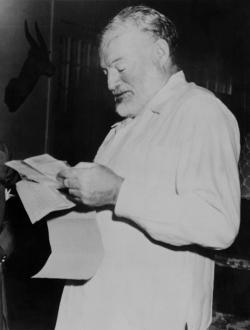Quote Investigator is a terrific website that examines the provenance of popular quotations, which, as you may have noticed, frequently get misattributed online. On Monday, the site’s proprietor, Garson O’Toole, looked into a six-word fiction supposedly written by Ernest Hemingway: “For sale: baby shoes, never worn.”
Hemingway’s authorship of the classified ad-inspired short-short story is frequently described as a “literary legend,” which, to be fair, is a perfectly accurate way of putting it. Snopes looked into the legend a few years ago, and decided that its basis in fact was “undetermined.” But after reading O’Toole’s more thorough investigation, it’s very hard to believe that Hemingway had anything to do with the tale.
Ernest Hemingway died in 1961, and the earliest published evidence known to QI connecting him to this tale appeared in 1991. The author Peter Miller included a version of the anecdote in his book Get Published! Get Produced!: A Literary Agent’s Tips on How to Sell Your Writing. Miller stated that he was told the tale by a “well-established newspaper syndicator” circa 1974.
The case for Hemingway does not get stronger from there. As O’Toole documents, the precursor to the story seems to be a 1921 newspaper column by Roy K. Moulton, who “printed a brief note that he attributed to someone named Jerry.”
There was an ad in the Brooklyn “Home Talk” which read, “Baby carriage for sale, never used.” Wouldn’t that make a wonderful plot for the movies?
That note was reprinted in multiple newspapers. A few months later, LIFE published the following squib, citing the Louisville Carrier-Journal.
The great American dramatist will be the man or woman who can write a one-act play as poignant as a seven-word want ad which the Houston Post discovers: For Sale, a baby carriage; never used.
O’Toole then traces the story through the 1920s—it made several more appearances, always using a carriage, not shoes—and then jumps ahead to the 1990s, when, after showing up in the self-help book mentioned above, it popped up elsewhere, too, now with the familiar image of shoes, rather than the arguably less evocative carriage, and attributed to Hemingway. Moulton also digs up a 1917 article from a magazine called The Editor, which suggested, as a title for a story about a mother who has lost her baby, “Little Shoes, Never Worn.”
Is that 1917 article, written by one William R. Kane, connected with the Hemingway legend as well? Perhaps. In any case, Kane seems a more likely “author” of the story than Hemingway is. And Moulton probably deserves the most credit, pending further evidence. Well, either Moulton or Jerry from Brooklyn. Or whoever was selling that baby carriage in 1921.
Previously:
When Ernest Hemingway Killed His Cat
